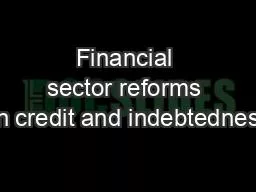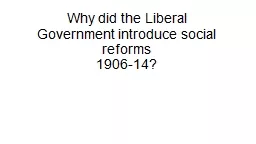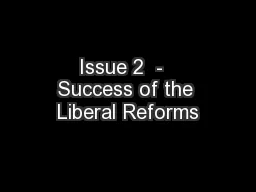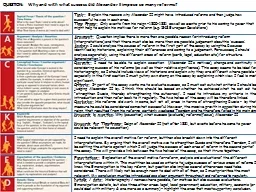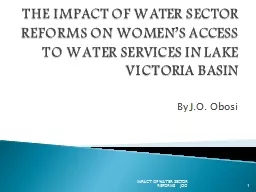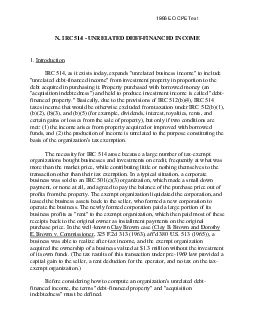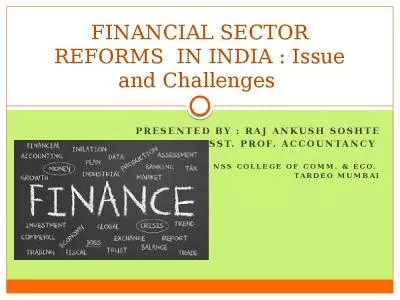PPT-Financial sector reforms on credit and indebtedness
Author : spiderslipk | Published Date : 2020-11-06
Presentation to the Portfolio Committee on Trade and Industry Presenter Ismail Momoniat DDG Tax and Financial Sector Policy National Treasury 13 May 2016 National
Presentation Embed Code
Download Presentation
Download Presentation The PPT/PDF document "Financial sector reforms on credit and i..." is the property of its rightful owner. Permission is granted to download and print the materials on this website for personal, non-commercial use only, and to display it on your personal computer provided you do not modify the materials and that you retain all copyright notices contained in the materials. By downloading content from our website, you accept the terms of this agreement.
Financial sector reforms on credit and indebtedness: Transcript
Presentation to the Portfolio Committee on Trade and Industry Presenter Ismail Momoniat DDG Tax and Financial Sector Policy National Treasury 13 May 2016 National Treasury South African Reserve Bank and Financial Services Board officials. Learning Intention. To be able to discuss the background to the Liberal Reforms 1906-14.. Intro. Throughout the 19. th. Century, poverty became a massive problem in Britain.. As you have studied, the Liberal Government came to power in 1906 and decided to introduced a number of reforms (changes) in order to help the poor people in Britain.. 1906-14?. Background. In the years before WW1, the Liberal party were in power in Britain. . They acted under the principles of ‘Laissez Faire’ – the popular idea that individuals were responsible for their own wellbeing and that the Government should have very little input on peoples everyday lives.. ). Rijit. . Sengupta. CREW NRG-II Meeting. 27. th. . June, Lusaka (Zambia). 2. OUTLINE. . Background. Competition Reforms & FCR. Preparatory Work. Components of FCR. Process in CREW Countries. Odenda. Lumumba. Kenya Land Alliance. Community Land & Land Reforms. Review of Land Reforms between 1945 & 2015. There have two types of Land Reforms to debate i.e.. Traditional Land Reforms undertaken before 1990s. Why is Alex II called the ‘tsar liberator’? . Is. Alex II a ‘liberator’?. How successful were Alex II’s reforms? . How did his reforms affect the people?. What factors led to a . rise. of opposition, despite those reforms? . How is our understanding of history relevant to modern Britain?. Introduction. The context of the reforms -. . What were attitudes towards poverty like before 1906?. What help did the poor receive before 1906?. Higher History. Success of the Liberal Reforms. Task 1 . First Page - . How successful were the Liberal reforms?. Leave 2 pages between each heading- . Factor 1 - Reforms for the Young . Factor 2 - Reforms for the Old. Topic: . Explain the reasons why Alexander II might have introduced reforms and then judge how successful he was in each area.. Time Frame: . Only events from his reign – 1855-1881, as well as events prior to his coming to power that might help to explain his motives for reform (e.g. 1848 European Revolutions). By J.O. . Obosi. IMPACT OF WATER SECTOR REFORMS JOO. 1. Sessional paper no. 1 of 1999 on water in Kenya. Provision of water by local authorities. water sector reforms started in . year 2004. WASREB- WSB- WSPs. DIME Workshop, Business Environment Panel. Marialisa. Motta, . Director, Financial and Private Sector Development, Latin America & Caribbean Region . Co-Director, Investment Climate Practice; Financial and Private Sector Development Network. N1 Introduction IRC 514 as it exists today expands unrelated business income to include unrelated debt-financed income from investment property in proportion to the debt acquired in purchasing it Prop T.Y.B.COM. SEMESTER - V. MODULE - I . MICRO ECONOMIC OVERVIEW OF INDIA. 1.. NEW ECONOMIC POLICY 1991. 1.1 INTRODUCTION. The year 1991 is one of the most significant one of the economic history of . Prof. Lewis B Dzimbiri. Professor of Public Administration. University of Malawi. Chancellor College. ZOMBA. Broad presentation outline. Aims and rationale of public sector reforms in Africa and Malawi. . soshte. Asst. . prof. . accountancy . Nss. college of comm. & eco. . tardeo. . mumbai. FINANCIAL SECTOR REFORMS IN INDIA : Issue and Challenges . Financial sector reform process . Remove financial repression that existed earlier,.
Download Document
Here is the link to download the presentation.
"Financial sector reforms on credit and indebtedness"The content belongs to its owner. You may download and print it for personal use, without modification, and keep all copyright notices. By downloading, you agree to these terms.
Related Documents

